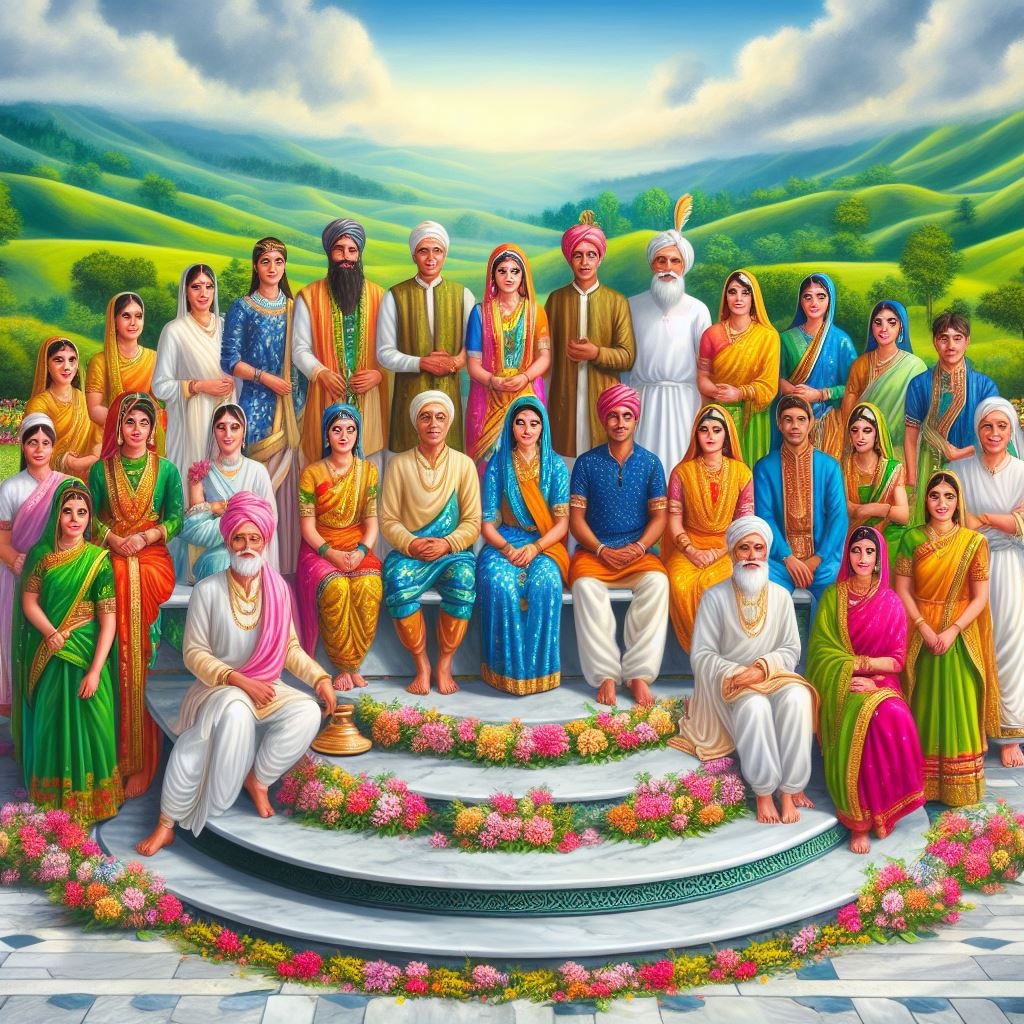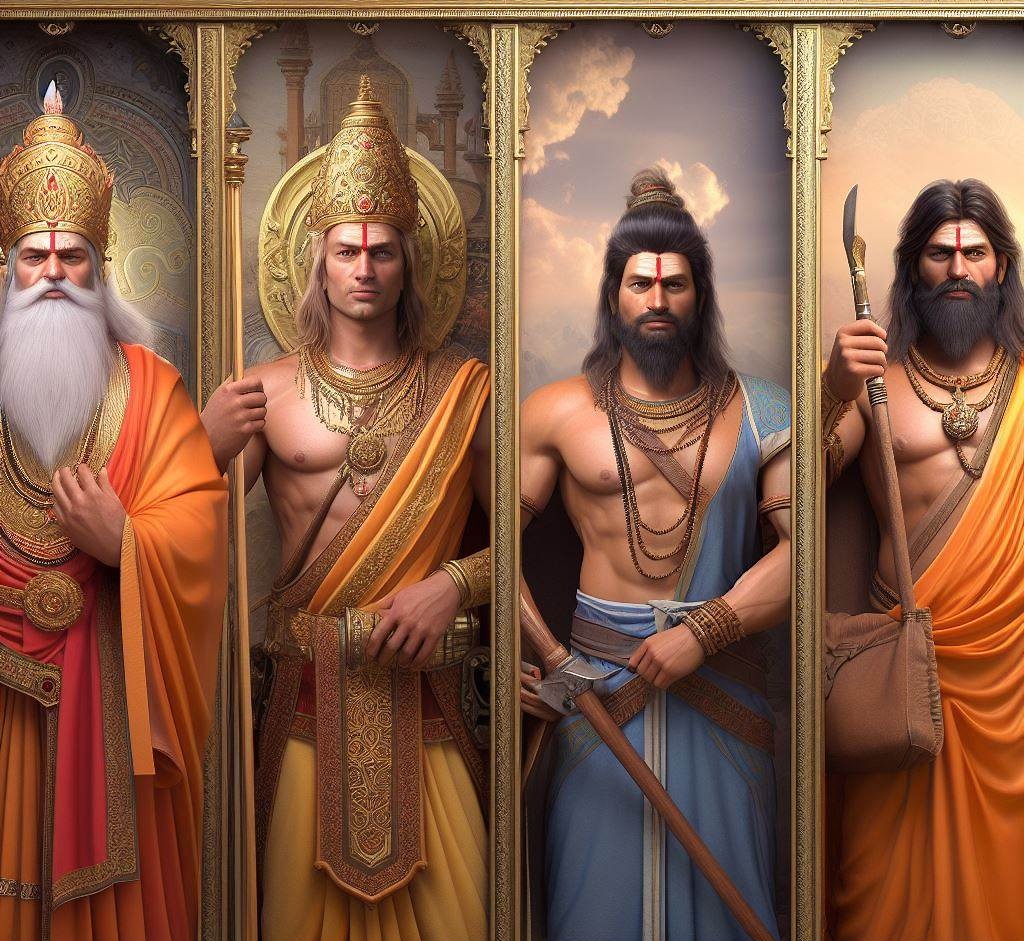Embark on a captivating exploration of the Varna System, a complex social order intricately woven into the tapestry of ancient Hindu traditions. Rooted in sacred scriptures and cultural practices, this system offers profound insights into the societal dynamics of bygone eras. Our journey takes you through the historical evolution of the Varna System, unraveling its significance and cultural implications that have shaped Hindu society.
As we navigate the intricate layers of this social structure, we delve into the roles, responsibilities, and interactions within each Varna. Beyond a surface-level understanding, our exploration aims to uncover the profound influence of the Varna System on various aspects of ancient Hindu society, from daily life to religious practices. This historical odyssey invites you to appreciate the complexities that defined societal norms and relationships, fostering a deeper understanding of an era steeped in cultural heritage.
Origins and Evolution of Varna System
Delve into the ancient roots and profound significance of the Varna System, an intricate social structure that has left an indelible mark on Hindu traditions. The origins of the Varna System can be traced back to sacred Hindu scriptures, where it was conceptualized to organize society based on distinct roles and responsibilities.
In its essence, the Varna System comprises four primary varnas, namely Brahmins, Kshatriyas, Vaishyas, and Shudras, each assigned specific duties and functions. Brahmins, associated with knowledge and spirituality, held a revered position, followed by Kshatriyas responsible for protection and governance, Vaishyas engaged in trade and agriculture, and Shudras involved in service and support roles.
Unlike contemporary misconceptions, varnas weren’t hereditary; instead, they were determined by an individual’s chosen profession and for instance in one family of 4 people can be of different Varna depending on their talent and choices . In this system, there existed no hierarchy; each varna held equal importance, much like the interdependence of different parts of the human body. Brahmins encompassed scientists, teachers, and thinkers, providing guidance akin to the brain; Kshatriyas defended, akin to the protective hands; Vaishyas managed resources, symbolizing the nurturing stomach, while Shudras, the working class, moved the societal body forward with their hard work akin to the legs . This nuanced perspective challenges modern preconceptions, revealing a holistic societal framework that valued every individual’s contribution.
The significance of the Varna System lies in its attempt to create a harmonious societal structure where individuals could contribute to the collective well-being based on their inherent qualities and aptitudes. While the system has evolved over time and faced criticism for rigidity, understanding its origins provides valuable insights into the historical, cultural, and religious contexts that shaped ancient Hindu society.
The Four Varnas Defined
In ancient Hinduism, the Varna System, a social structure, categorized society into four varnas, each with distinct roles.
Brahmins (Head/Brain): Brahmins were akin to the head or brain of society. Comprising scholars, scientists, and teachers, their role was to guide and impart wisdom. They were responsible for determining what was right or wrong, akin to the brain directing the body.
Kshatriyas (Hands/Protectors): The Kshatriyas were considered the hands of society. They held roles in the military and were responsible for protecting the community from external threats. Analogous to how hands defend the body, Kshatriyas safeguarded society.
Vaishyas (Stomach/Providers): Vaishyas were regarded as the stomach of society. Much like the stomach stores and provides nourishment, Vaishyas managed resources, including food and wealth. They played a vital role in sustaining the community.
Shudras (Legs/Workers): Shudras represented the legs of society. Their function was to carry the community forward, much like legs propel the body. In ancient times, Shudras constituted the working class, and their duty was to contribute to the progress of society.
Importantly, these varnas weren’t predetermined by birth but were based on an individual’s chosen profession. The system aimed at ensuring each segment of society worked cohesively, emphasizing equal value for all varnas without hierarchical distinctions.
Philosophical Underpinnings of Varna syastem
The Varna System in ancient Hinduism finds its philosophical underpinnings deeply rooted in the concept of Dharma, Karma, and the pursuit of a balanced and harmonious society.
Dharma (Righteous Duty): Dharma, the moral and ethical duties prescribed in Hinduism, played a central role in the Varna System. Each varna was assigned specific duties, and adhering to one’s dharma was considered crucial for individual and societal well-being.
Karma (Action and Consequences): The Varna System was closely tied to the concept of Karma. Individuals were expected to perform their designated duties diligently, understanding that their actions (Karma) would influence their present and future circumstances. This emphasis on Karma reinforced the idea of personal responsibility.
Societal Balance: The Varna System aimed at creating a harmonious and well-balanced society. By delineating roles and responsibilities based on individual capabilities and inclinations, it sought to prevent societal discord. Each varna was seen as an integral part of the whole, contributing to the smooth functioning of the societal organism.
Spiritual Evolution: The system was not just a social construct but also had spiritual implications. Individuals were encouraged to move beyond their assigned varna through spiritual growth. The ultimate goal was self-realization and liberation (Moksha), transcending the limitations of societal roles.
Equality in Diversity: Contrary to misconceptions, the Varna System was not meant to establish a hierarchy. Instead, it celebrated the diversity of human skills and talents, recognizing the equal importance of each varna in the grand scheme of societal functioning.
Understanding the philosophical foundations of the Varna System provides insights into how ancient Hindu society envisioned a structured and purposeful way of life, aiming at both individual fulfillment and societal harmony.
Challenges and Criticisms in Varna system
While the Varna System in ancient Hinduism was designed with the intention of creating a structured and harmonious society, it faced several challenges and criticisms over time as some corrupt elements get introduced in it with time .
Rigidity and Birth-Based Classification: One of the primary criticisms is the perceived rigidity of the system, particularly the notion of varna being determined by birth. This led to the entrenchment of social classes, hindering social mobility and opportunities for those outside their assigned varna.
Social Inequality: Despite the philosophical ideals of equality, the practical application of the Varna System sometimes resulted in social disparities. The varnas were not always treated with equal respect and opportunities, leading to a hierarchical societal structure.
Discrimination and Untouchability: The emergence of the concept of untouchability and the mistreatment of certain varnas, especially those considered as “Shudras,” became a significant drawback. This discrimination contradicted the core principles of equality and mutual respect.
Erosion of Individual Merit: The system’s focus on hereditary roles sometimes led to situations where individual merit and capabilities were overshadowed by birth-based considerations. This hindered the recognition and utilization of talent within the society.
Cultural and Economic Implications: The Varna System, in practice, had cultural and economic implications, with certain varnas enjoying privileges while others faced social and economic challenges. This unequal distribution of resources and opportunities contributed to societal tensions.
Misinterpretation and Misuse: Over time, the original philosophical intentions behind the Varna System were sometimes misunderstood or misused for vested interests. This misinterpretation led to deviations from the system’s ethical and moral foundations.
Relevance in Modern Society: In contemporary times, the Varna System faces challenges regarding its relevance in a more egalitarian and democratic society. The traditional roles assigned by the system may not align with the principles of equal opportunities and individual freedom.

Legacy and Contemporary Relevance of the Varna System
The Varna System, despite its historical complexities and criticisms, leaves a lasting legacy that continues to influence societal perceptions and dynamics. Understanding its historical context is crucial to evaluating its contemporary relevance.
Legacy:
Cultural Foundation: The Varna System laid the cultural foundation for ancient Hindu society, shaping social norms, traditions, and values. It provided a framework for organizing communities based on distinct roles and responsibilities.
Philosophical Insights: The philosophical underpinnings of the Varna System, as seen in texts like the Vedas and Upanishads, offered insights into the ideal of a well-ordered society. Concepts of dharma (duty) and karma (action) were integral to the system’s ethical framework.
Diversity and Interdependence: By categorizing society into distinct varnas, the system acknowledged and promoted the idea of diversity and interdependence. Each varna was considered essential for the overall functioning of society, mirroring the harmony found in nature.
Contemporary Relevance:
Social Awareness: In contemporary times, an understanding of the Varna System contributes to social awareness and discussions on historical socio-cultural structures. It prompts reflections on the evolution of societal norms and the impact of ancient traditions on the present.
Ethical Considerations: The philosophical principles embedded in the Varna System, such as the emphasis on duty and righteous conduct, continue to resonate in discussions on ethics and morality. These concepts remain relevant for individuals navigating complex moral dilemmas.
Cultural Identity: The Varna System, despite its challenges, forms part of the cultural identity of communities adhering to Hindu traditions. It serves as a historical reference point that shapes cultural practices and interpretations.
Social Equality Discourse: Discussions around the challenges and criticisms of the Varna System contribute to broader conversations about social equality and justice. They encourage societies to reflect on historical injustices and work towards creating more equitable structures.
Education and Scholarship: The study of the Varna System remains integral to academic pursuits in fields like history, sociology, and religious studies. Scholars engage with its nuances to unravel the intricacies of ancient societal structures.
While the Varna System is a product of its time, acknowledging its legacy and critically examining its contemporary implications fosters a nuanced understanding of its role in shaping cultural, social, and philosophical dimensions over the centuries.
Influence on Cultural Practices in the Varna System
The Varna System, deeply ingrained in ancient Hindu society, exerted a profound influence on various cultural practices. From religious rituals to social norms, the system played a pivotal role in shaping the cultural landscape of the time.
1. Rituals and Ceremonies:
- Sacred Duties (Yajnas): Each varna had specific duties outlined in religious ceremonies. Brahmins, for instance, were responsible for performing rituals, reciting sacred texts, and conducting yajnas (fire sacrifices).
- Life Cycle Events: The Varna System influenced rites of passage, including birth ceremonies, initiation rituals, weddings, and funeral rites. The varna of individuals often determined the nature and intricacies of these ceremonies.
2. Festivals and Celebrations:
- Varna-Specific Celebrations: Certain festivals and celebrations were linked to specific varnas. For example, academic achievements might be celebrated within the Brahmin community, while martial accomplishments were highlighted in the Kshatriya community.
3. Art and Literature:
- Cultural Contributions: Each varna made distinct contributions to art and literature. Brahmins, as scholars, played a key role in preserving and transmitting knowledge through ancient texts. Kshatriyas, with their emphasis on valor, influenced epics and tales of heroism.
4. Social Hierarchies:
- Traditional Roles: The Varna System established social hierarchies that reflected in cultural practices. Brahmins were often revered, Kshatriyas held positions of authority, Vaishyas engaged in trade, and Shudras contributed to manual labor. These roles were reflected in cultural narratives.
5. Language and Communication:
- Linguistic Influence: The varna of individuals sometimes influenced language use and communication styles. Brahmins, associated with scholarship, might have had a distinctive manner of expression, while Kshatriyas might have emphasized martial oratory.
6. Clothing and Adornments:
- Symbolic Attire: Cultural practices related to attire and adornments often carried symbolic significance associated with varna. Brahmins might wear specific garments denoting their role, and Kshatriyas might have distinctive symbols of valor.
7. Food and Dietary Practices:
- Occupation-Based Diets: The Varna System influenced dietary practices, with each varna having dietary preferences based on their occupations. For instance, Brahmins may have adhered to a diet that supported intellectual pursuits , similarly Kshatriyas need diet to keep themselves stronger , and so do the Shudras who do the physical labour .
8. Cultural Norms:
- Norms of Interaction: The cultural practices surrounding social interaction, marriage, and community gatherings were often influenced by the Varna System. Marriages, in particular, were expected to align with the varna of individuals.
While the Varna System is a historical construct, its impact on cultural practices is evident in the historical records and texts that provide insights into the daily lives and customs of ancient Hindu society.
Adaptations and Transformations in the Varna System
Over the course of history, the Varna System underwent adaptations and transformations, responding to social, economic, and cultural shifts. While the system was initially conceived with a certain framework, its evolution showcased a dynamic nature that allowed for adjustments.
1. Economic Changes:
- Shifts in Occupation: As societies evolved and economies diversified, the rigid occupational divisions of the Varna System saw modifications. The linkage between varna and occupation became more flexible, allowing individuals to pursue a broader range of professions.
2. Social Mobility:
- Emergence of Jatis: The emergence of Jatis (sub-castes) added a layer of complexity to the Varna System. While the varna remained a theoretical classification, Jatis often became more practical indicators of social identity, allowing for greater social mobility.
3. Educational Opportunities:
- Widening Access to Education: Changes in educational opportunities contributed to adaptations in the Varna System. With increased access to education, individuals from various varnas could pursue intellectual and scholarly endeavors, challenging traditional norms.
4. Legal Reforms:
- Legal Interventions: Legal reforms played a role in transforming the Varna System. Anti-discrimination laws and affirmative action measures aimed to address historical inequalities and provide opportunities for marginalized communities.
5. Cultural Integration:
- Syncretism and Fusion: Cultural integration and syncretism led to the blending of traditions across varnas. Festivals, rituals, and cultural practices became more inclusive, reflecting a shared cultural identity rather than rigid varna-specific customs.
6. Modern Professions:
- Diversification of Professions: In contemporary times, the Varna System’s link to specific professions has blurred. People from diverse varnas engage in various professions, challenging the traditional association of occupations with specific social groups.
7. Social Awareness:
- Consciousness and Activism: Increased social awareness and activism have led to questioning and challenging caste-based discrimination. Movements advocating for social equality have contributed to redefining societal attitudes toward varna-based distinctions.
8. Inter-Caste Marriages:
- Breaking Barriers: Inter-caste marriages have become more prevalent, challenging the traditional boundaries of the Varna System. Such unions contribute to the breaking down of social barriers and fostering a more integrated society.
9. Globalization:
- Impact of Global Influences: Globalization has played a role in shaping perspectives on the Varna System. Exposure to diverse cultures and ideologies has influenced societal attitudes, encouraging more inclusive and egalitarian values.
10. Constitutional Changes:
- Constitutional Amendments: Legal frameworks, including constitutional amendments, have aimed to abolish untouchability and promote equality. These changes reflect broader societal shifts toward a more inclusive and equitable social structure.

Learning from History in the Varna System
Understanding the historical trajectory of the Varna System offers valuable lessons that can shape contemporary perspectives and foster a more inclusive society.
1. Cultural Pluralism:
- Embrace Diversity: The historical development of the Varna System illustrates the existence of a complex and diverse social fabric. Acknowledging this diversity fosters a culture of acceptance and appreciation for different backgrounds and traditions.
2. Social Justice:
- Addressing Historical Injustices: Reflecting on historical injustices embedded in the Varna System underscores the importance of addressing social inequities. Learning from past mistakes encourages the pursuit of social justice and equality for all.
3. Evolving Social Structures:
- Adaptability in Changing Times: The evolution of the Varna System highlights the adaptability of social structures. Recognizing that societies are dynamic and subject to change encourages openness to transformations that promote inclusivity.
4. Education and Awareness:
- Promote Education: History teaches us the power of education in challenging stereotypes and promoting awareness. Emphasizing the importance of education in dispelling misconceptions and fostering understanding can lead to a more enlightened society.
5. Unity in Diversity:
- Celebrate Unity: The historical interplay of varnas and sub-castes emphasizes the unity that underlies diversity. Appreciating the interconnectedness of different communities encourages the celebration of shared values and aspirations.
6. Social Harmony:
- Strive for Harmony: Learning from historical divisions encourages efforts to build social harmony. By fostering understanding and empathy, societies can work towards unity, transcending the limitations imposed by historical structures.
7. Equality and Inclusion:
- Promote Equal Opportunities: The historical legacy of the Varna System calls for a commitment to providing equal opportunities for all individuals. Promoting inclusivity and dismantling discriminatory practices contribute to a fair and just society.
8. Progressive Legislation:
- Support Legal Reforms: History demonstrates the impact of legal interventions in challenging discriminatory practices. Advocating for and supporting progressive legislation reinforces the commitment to creating a more equitable and just social order.
9. Collective Responsibility:
- Shared Responsibility: Understanding the complexities of history underscores the importance of a collective responsibility for societal well-being. Each individual has a role to play in promoting understanding, tolerance, and harmony.
10. Dialogue and Discourse:
- Encourage Open Dialogue: History emphasizes the significance of open dialogue and constructive discourse. Encouraging conversations that challenge preconceived notions and promote understanding contributes to social cohesion.



